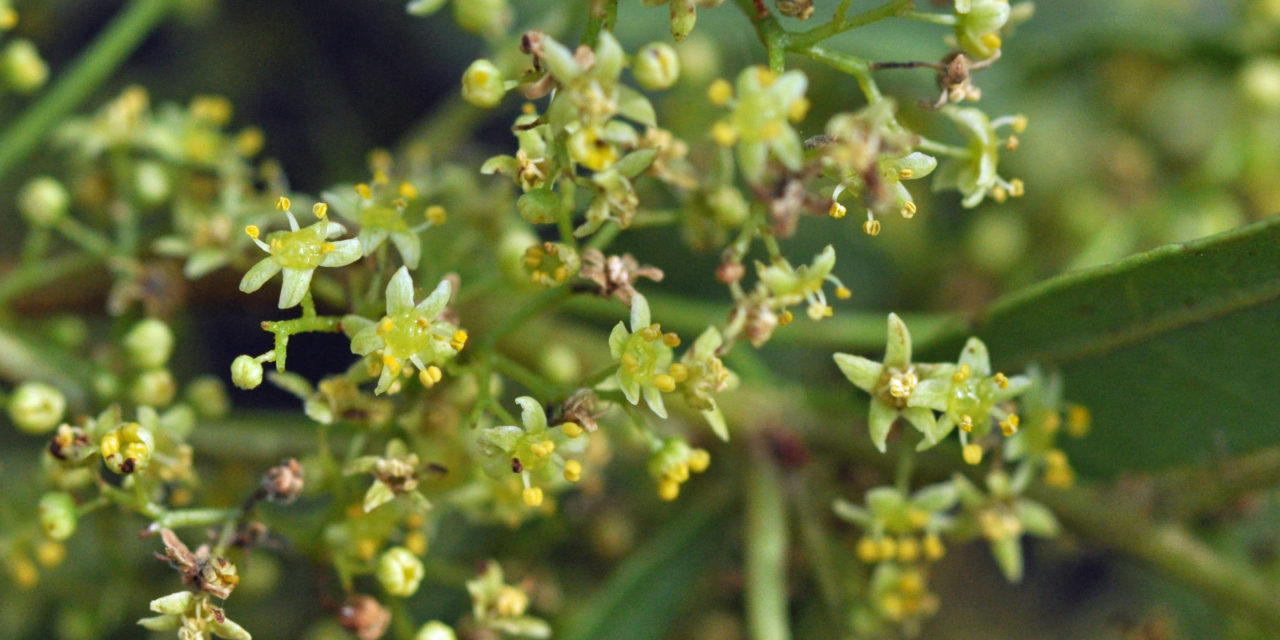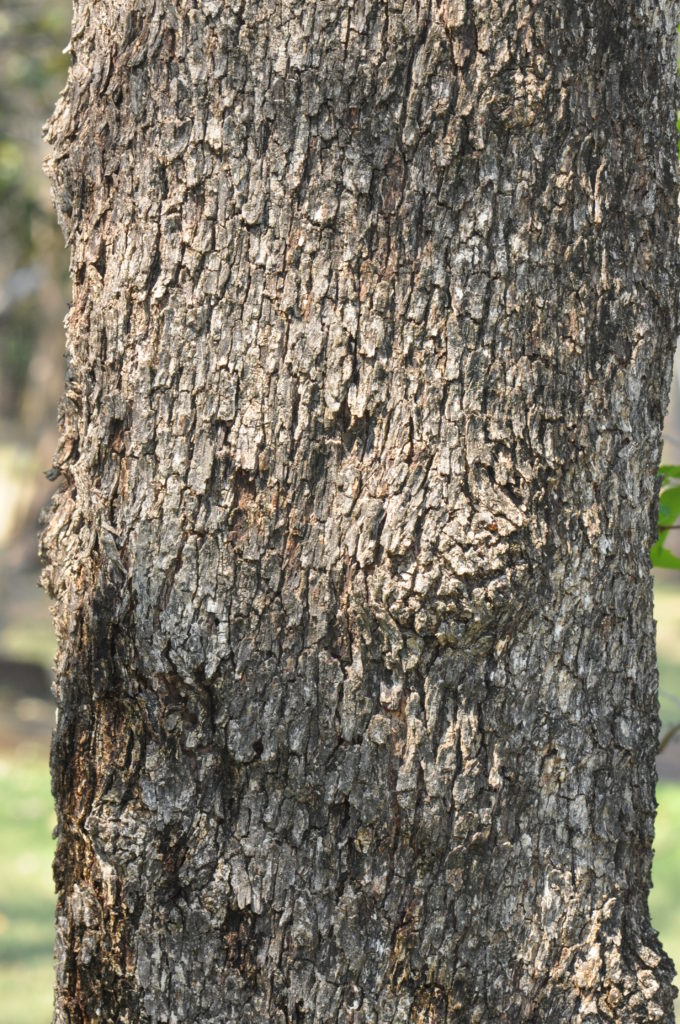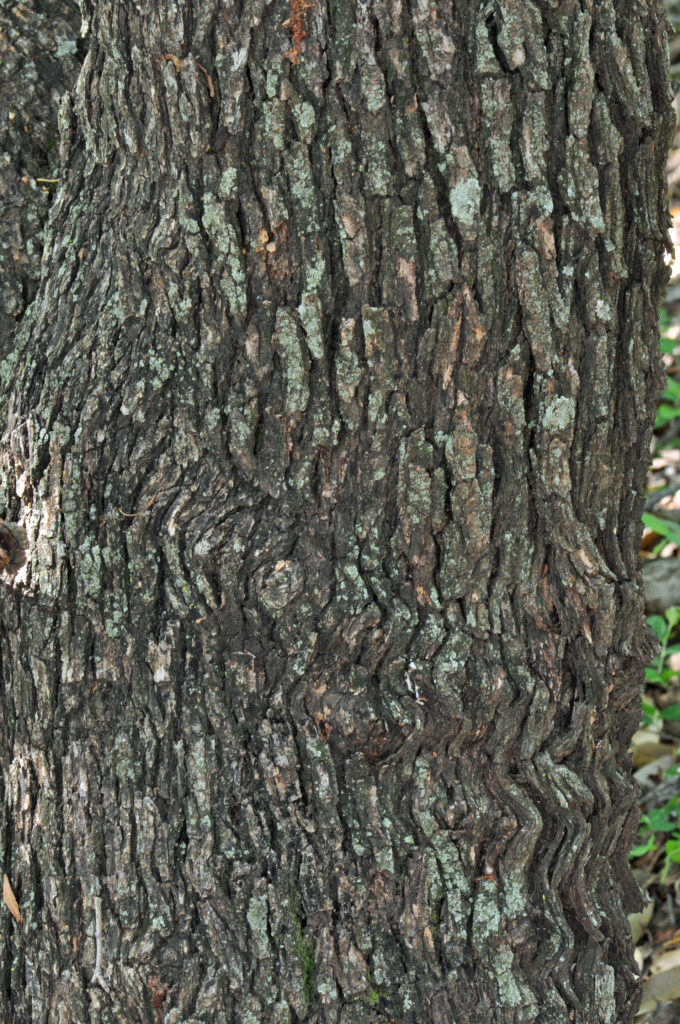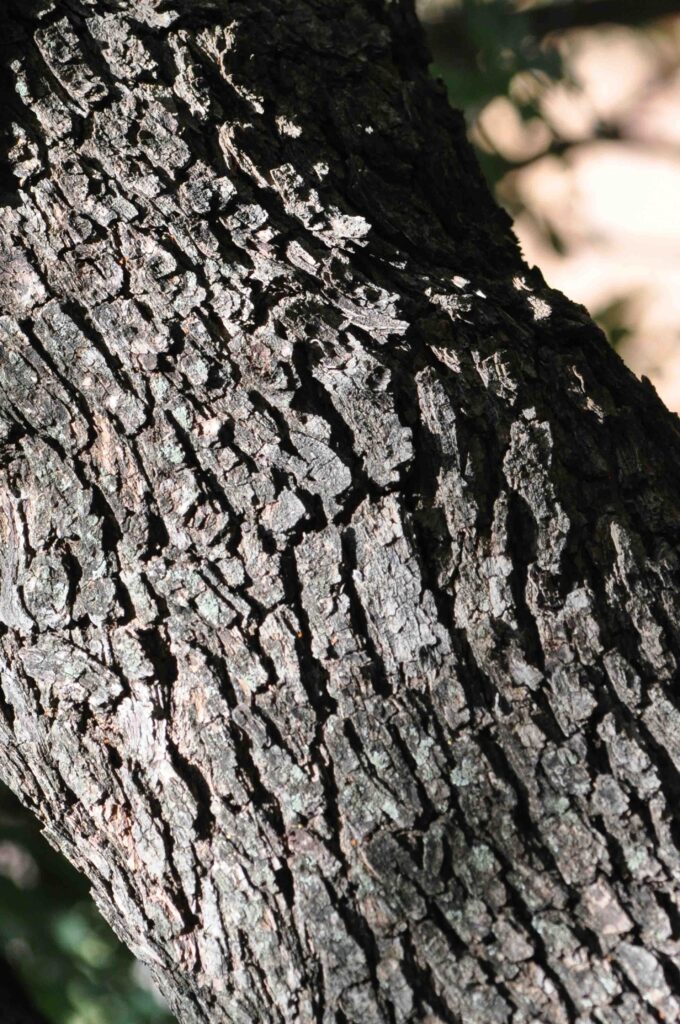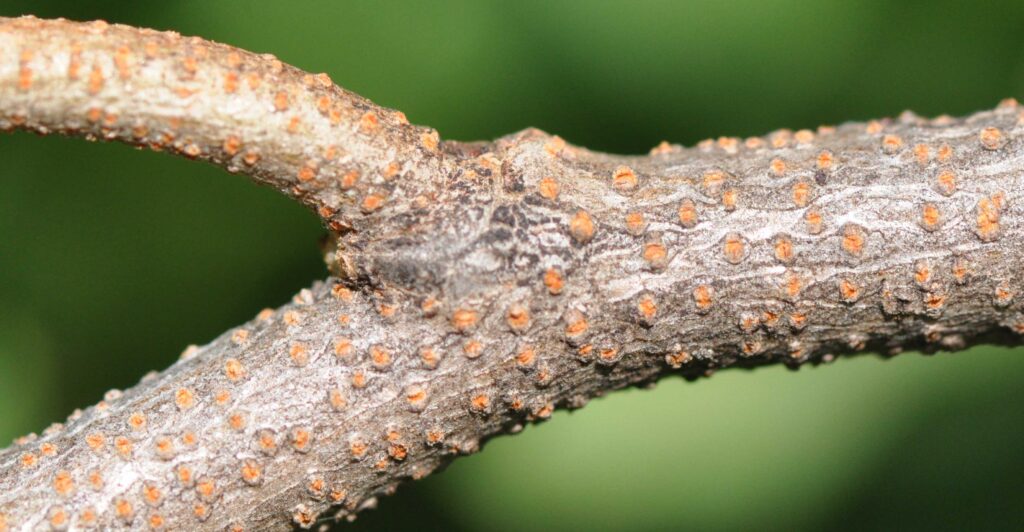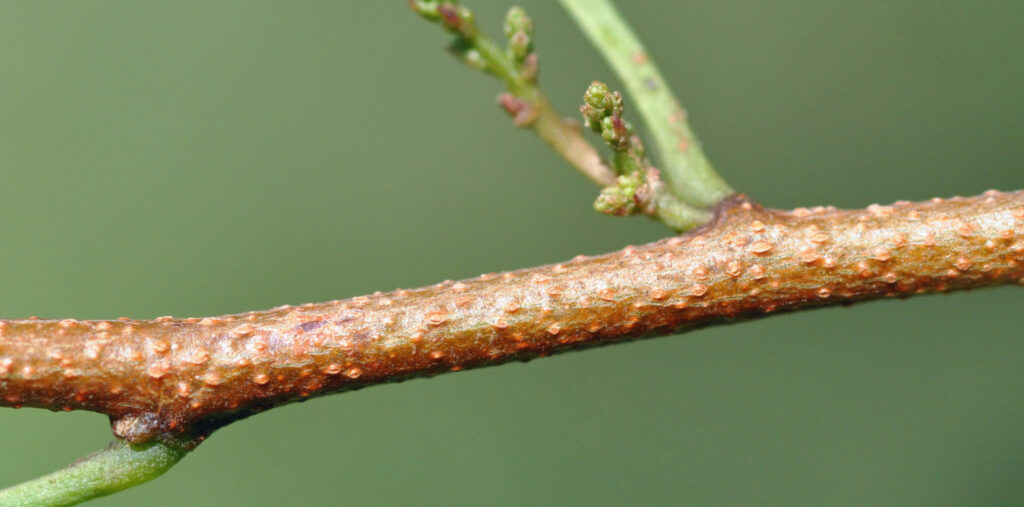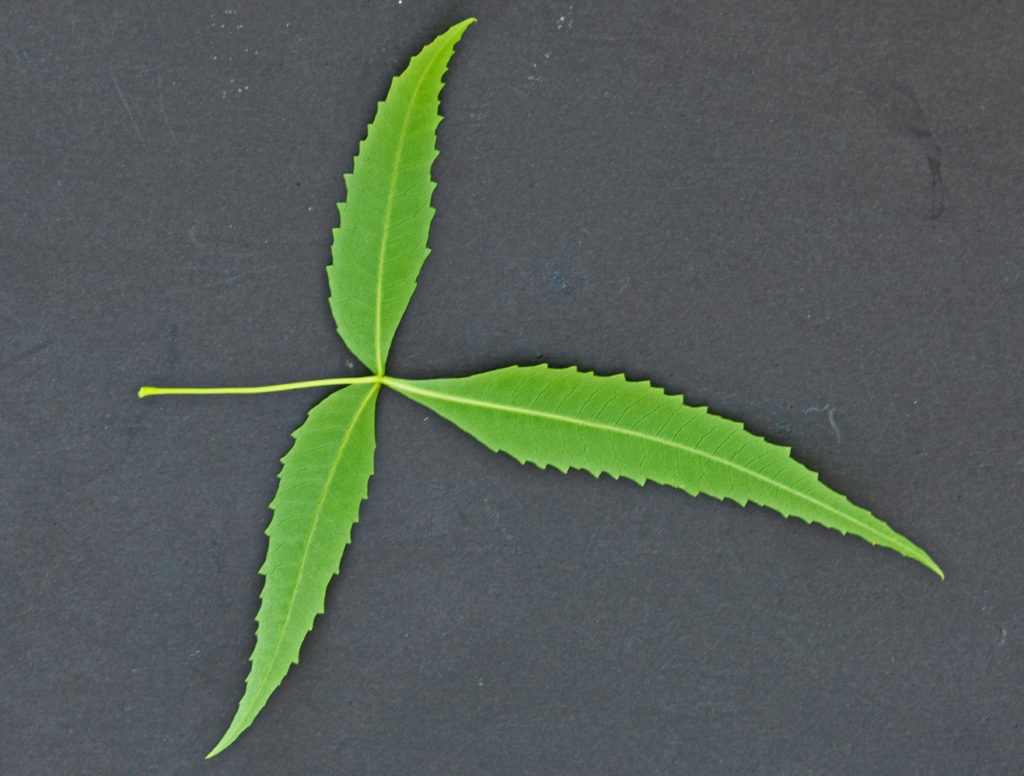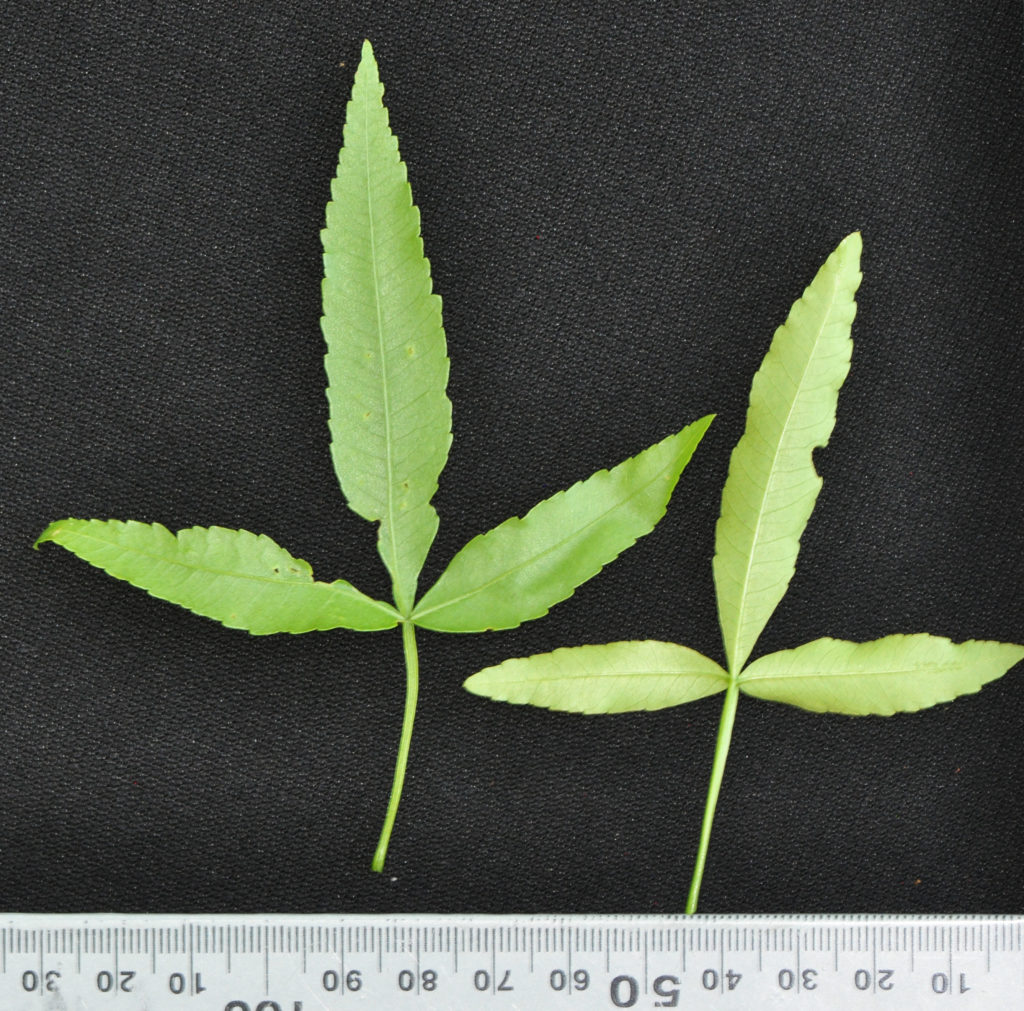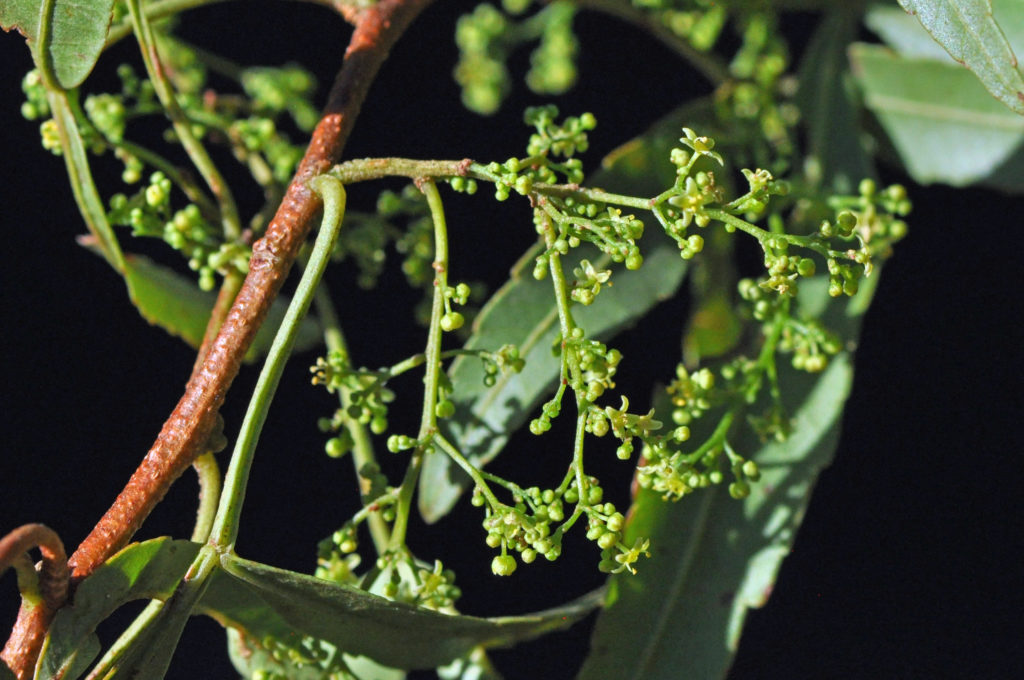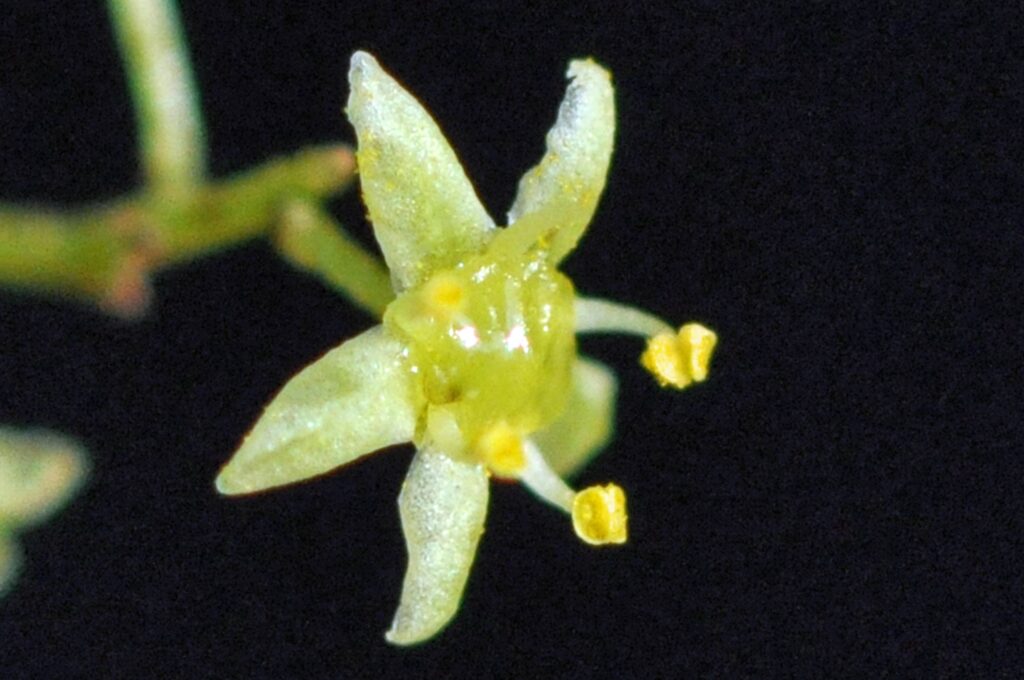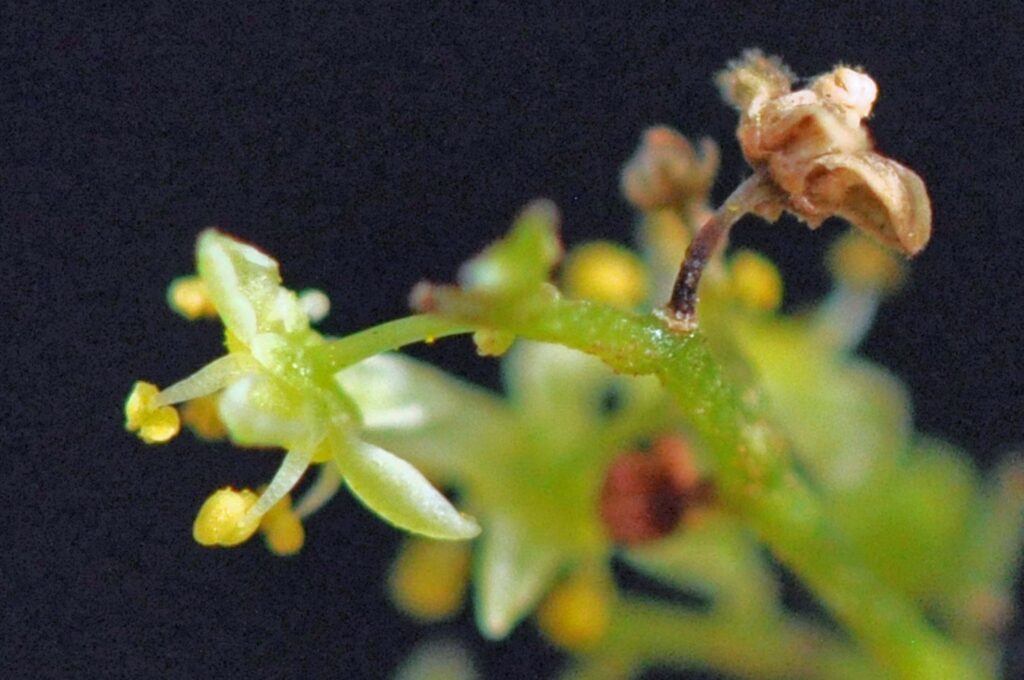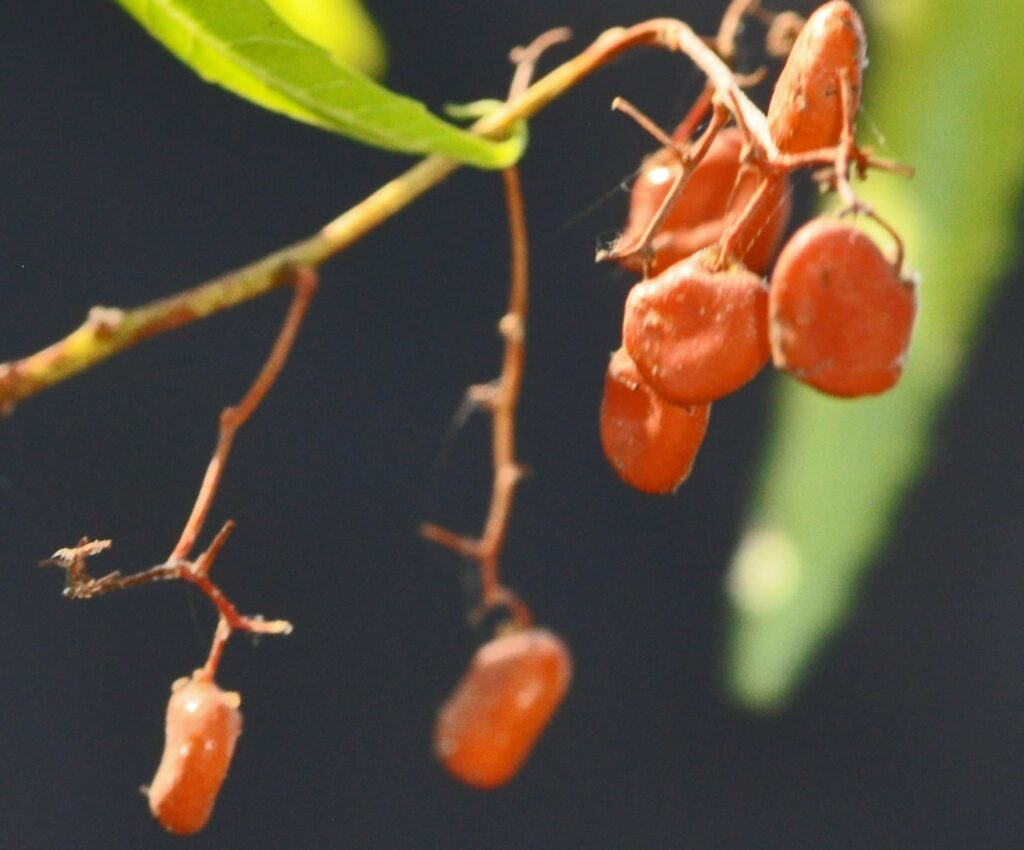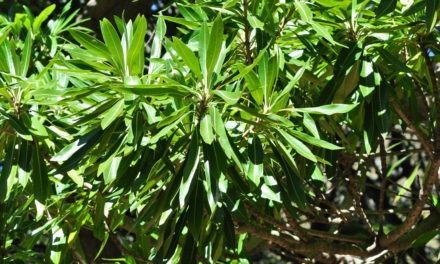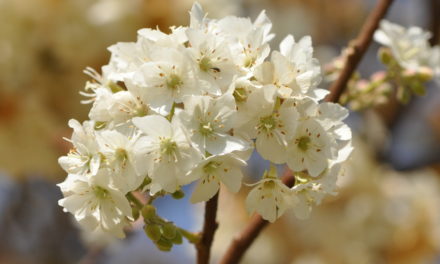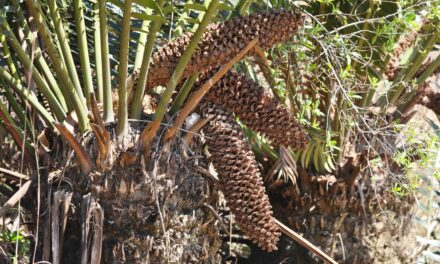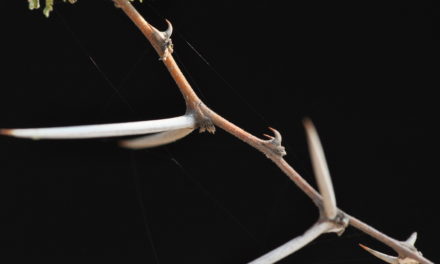General Info – summary
This dioecious Tree may reach 5m+ high and has a longitudinally furrowed dark trunk. Young branches have reddish lenticels. The trifoliate Leaves usually have scalloped or toothed leaflets that are close to 90 degrees from the central leaflet. Regular yellowish white 5-merous Flowers are unisexual. The round, flattened & shiny Fruit is a drupe with reniform seeds. This frost resistant tree is a good garden prospect.
Description
Searsia leptodictya
Previous Names: Rhus amerina, Rhus leptodictya, Rhus rhombocarpa.
SA Tree No. 387.
Common names: (Afr) Bergkaree, Klipkaree. (Eng) Mountain Karree, Rock Karree. (Northern Sotho) Mohlwehlwe. (siSwati) Inhlangutshane.
Family: Anacardiaceae. (Mango family), which has about 83 genera and 850+ species – including Cashew). About 80 species occur in South Africa. Hunting arrows have been made from straight stems. Resin canals are present and woolly stellate hairs cover all young parts. Leaves lack stipules. They may be deciduous or evergreen and usually alternate. Leaves are simple, trifoliate or digitally compound and imparipinnate. Leaflets are usually opposite. Crushed leaves may smell of turpentine. Trees are monoecious or dioecious with occasional bisexual Flowers. Flowers are small, greenish or yellowish white and usually regular. The Calyx has 4-7 sepals and there are 4-7 Petals. The number of Stamens is the same as, or twice the number of petals and the Anthers are versatile. The superior Ovary has up to 4 locules, each with a single ovule. The 1-5 Styles are free or connate and separated at the base. Fruit is usually an indehiscent fleshy drupe that provide food in dry areas. They contain a single quick growing Seed. The southern Africa genera containing trees on this website include Harpephyllum, Lannea, Loxostylis, Ozoroa, Sclerocarya and Searsia.
Name derivation: Searsia – Named after Paul Bigelow Sears a highly qualified American ecologist (December 17, 1891 – April 30, 1990). He pioneered the study of fossil pollen in the USA. leptodictya – fine or thin – referring to the network veins in the leaflets. There are many species in the genus Searsia in the South Africa. DNA research has confirmed difference between the European Rhus and our Searsia.
Conservation: National Status: L C (Least Concern). Assessed 2018 (L. von Staden).
Tree
This spineless spreading shrub or small Tree may reach 9m high (usually about half this height). The Bark on the Trunk becomes longitudinally furrowed and dark grey to blackish (photos 959++). This is similar to S. lancea. Branches are smooth, reddish brown and tend to hang down loosely and Branchlets (usually applied to branches of the current or preceding year) may have velvety hairs. They are also reddish brown (photo 325) and pendulous. Young branches have visible reddish Lenticels (a usually raised corky oval or elongated area on the plant that allows the uncontrolled interchange of gases with the environment -photos 328 & 325).
- 959 2014.09.15 Lowveld NBG. Photo: David Becking.
- 645 2016.11.22 Pretoria NBG. Photo: David Becking.
- 312 2014.02.18. Marakele NP. Photo: David Becking.
- 328 2018.01.18 Pretoria NBG. Photo: David Becking.
- 325 2018.01.18 Pretoria NBG. Photo: David Becking.
Leaves
On this deciduous tree, the leaves fall in winter. The thinly textured Leaves are pale olive green above and slightly lighter below (photo 644). Leaves are trifoliate (compound leaf with 3 leaflets). The wavy, soft, droopy Leaflets are relatively narrow, lanceolate to oblong lanceolate. The longest terminal or middle leaflet is up to 11 x 2,5cm and lateral leaflets are smaller and situated close to 90 degrees to the central leaflet. This helps with ID (photo 961). Veins are more visible above (photo 644) and the Midrib is clearly visible on both surfaces (photo 644). Occasional very short hairs may be present on the lower side. The Apex is broadly to narrowly tapering and may end in a distinct point (photo 961). The Base tapers and may be asymmetric (not equal to the opposite side). The Margins may be shallowly to deeply toothed – from near the base to the apex (photo 961). Leaflets are occasionally entire (with a continuous margin, not in any way indented). The thin, wingless Petiole (leaf stalk) is up to 4,5cm long and may be reddish. Petiolules (leaflet stalks) and Stipules (basal appendage of the petiole) are absent. Crushed leaves have a resinous smell.
- 961 2014.09.15 Lowveld NBG. Photo: David Becking.
- 644 2016.11.22 Pretoria NBG. Photo: David Becking.
Flowers
These plants are dioecious (unisexual floral structures with male and female parts on separate plants). The small greenish or yellowish-white Flowers are visible because of their large numbers. They develop in Panicles (indeterminate, branched inflorescence with stalked flowers – photo 751) which are up to 12cm long forming large sprays. Individual flowers are unisexual and actinomorphic (Regular, symmetrical. Flowers are vertically divisible into similar halves by more than 1 plane passing through the axis). A roughly circular Disc (a more or less fleshy or elevated development of the receptacle) is present. The Calyx has 5 Sepals which are joined at the base and the Corolla has 5 free Petals (photo 895). Male flowers lack an Ovary. Here there are 5 Stamens with free filaments (photo 894). The Anthers have 2 Thecae (pollen sacs) present and dehiscence is through longitudinal slits. The Female flowers have a single Pistil (a unit of the Gynoecium, the female element of the flower, composed of the Ovary, Style and Stigma) containing a superior Ovary. Three free Styles with capitate (formed like a head) Stigmas are present. 5 Staminodes (sterile stamens) are also present. (Sep-Apr).
- 751 2018.02.12 Pretoria NBG. Photo: David Becking.
- 895 2018.03.01 Pretoria NBG. Photo: David Becking.
- 894 2018.03.01 Pretoria NBG. Photo: David Becking.
Fruit
All the indigenous Searsia species in South Africa have edible fruit that are rich in carbohydrates. The Fruit is a flattened shiny and hairless Drupe (stone fruit like a peach but much smaller in this case – up to about 6 x 2mm) with a thin pulp layer. Mature fruits are yellow to red-brown (photo 963). (Mar-Jun). The reniform Seeds lack endosperm (the starch and oil-containing tissue of many seeds; often referred to as the albumen). (Mar-Jun).
- 963 2014.09.15 Lowveld NBG. Photo: David Becking.
Distribution & Ecology
This plant occurs in a wide variety of habitats and is found up to an altitude of 2 000m in rocky hillsides, particularly in granitic (an igneous rock that develops underground when silica rich molten rock cools) areas. They also occur in open woodland, forest margins, in grasslands and bushveld (is a sub-tropical woodland ecoregion of southern Africa) and in savanna (is a rolling grassland scattered with shrubs and isolated trees, which can be found between a tropical rainforest and desert biome). Plants occur in Central Free State, KwaZulu-Natal, North West, Gauteng – common round Johannesburg and Pretoria, Mpumalanga, Limpopo, Swaziland, Zimbabwe, southern Mozambique, Botswana, Malawi, Namibia and Angola. Many Birds, including barbets, doves, bulbuls, mousebirds and white-eyes, eat the Fruit. Birds disperse the reniform (kidney-shaped) Seeds that survive passing through their digestive system. Eland, Giraffe, Kudu and Blue duiker are among the herbivores that consume the Leaves. Leafy green Branches are used to line the nests of Verreaux’s Eagle (Black Eagle). This is because they have a disinfectant property that helps protect the nests from disease. Verreaux’s Eagle (Aquila verreauxii) prey extensively on the rock hyrax or Dassie (Procavia capensis).
Ethnobotany
This Tree grows quickly (about 1m per year) from Seed. It can grow on a variety of soils and does not have an aggressive root system. Plants do better in full sun in and well drained soils. This is a good tree for attracting birds. In order to obtain fruit, both male and female trees must be reasonably close together. Here cuttings grown from male and female trees would ensure this. The use of plant extracts in laboratory, as an anti-diarrhoea medication has been successful, and more tests are to be carried out. This decorative frost and drought resistant tree is a good garden prospect but sensitive to severe frost. Local medicine makes use of various plant parts.
References
Boon, R. 2010. Pooley’s Trees of eastern South Africa. Flora and Fauna Publications Trust, Durban.
Burrows, J.E., Burrows, S.M., Lotter, M.C. & Schmidt, E. 2018. Trees and Shrubs Mozambique. Publishing Print Matters (Pty) Ltd. Noordhoek, Cape Town.
Coates Palgrave, M. 2002. Keith Coates Palgrave Trees of Southern Africa, edn 3. Struik, Cape Town.
Ginn, P.J. McIlleron, W.G. Milstein, S. 1989. The Complete Book of Southern African Birds. Struik Publishers (PTY) LTD. Third impression 1991.
Lawrence, G. H. M, 1951. Taxonomy of Vascular Plants. The Macmillan Company, New York. Tenth Printing 1965.
Palmer, E. & Pitman, N. 1972. Trees of southern Africa. Balkema, Amsterdam, Cape Town.
Schmidt, S. Lotter, M. & McCleland, W. 2002. Trees and Shrubs of Mpumalanga and the Kruger National Park. Jacana, Johannesburg.
van Wyk, B. & van Wyk, P. 1997 Field guide to Trees of Southern Africa. Struik, Cape Town.
von Staden, L. 2018. Searsia leptodictya (Diels) T.S.Yi, A.J.Mill. & J.Wen. National Assessment: Red List of South African Plants version 2020.1. Accessed on 2023/12/05.
http://www.plantzafrica.com/plantqrs/voteplant.php
https://en.wikipedia.org/wiki/Searsia_leptodictya
http://www.sanbi.org/creature/verreaux%E2%80%99s-eagle
http://posa.sanbi.org/flora/browse.php?src=SP

